by R. T. H.
HALSEY - an article from Metropolitan Museum of Art Bulletin 1 (January
1916)
(click on photos to enlarge image)
THE CLEARWATER COLLECTION OF COLONIAL SILVER
American Art -its expression by our painters, sculptors, and
craftsmen and the recognition of them by our people- was until
recent years handicapped by the belief that our art was of
recent growth and lacked the weight of history, tradition, and
inheritance, which in the minds of many seemed necessary for its
widespread recognition.
This erroneous belief is fast becoming dissipated, largely
owing to the development of collections of American decorative
art by the Metropolitan, Boston, and Providence museums. Their
examples are being followed by the managements of other museums,
notably the Brooklyn Institute and some of our large western
museums. By these collections they are demonstrating that
artistic sentiment has long existed here and played an important
part in the early social life of our people.
Colonial silver of the seventeenth and eighteenth centuries
in its perfection of form, texture, and craftsmanship may be
studied in the Clearwater Collection, now located in Gallery 22
on the second floor. All the pieces in this collection -the
result of years of patient gathering by Judge A. T. Clearwater-
were made in America, and with few exceptions are the work of
native-born Americans who had learned their trade in this
country. No student of American art and the development of
artistic taste in this country can fail to recognize the work
and influence of our early silversmiths, their artistic
conception and superb craftsmanship. Their handicraft is the
earliest expression we have of our forefathers’ appreciation of
the beautiful, an appreciation which became widespread as the
country prospered and furnished a steadily increasing patronage,
which encouraged a succession of craftsmen, whose works assisted
to beautify our American homes and today bear silent witness to
the artistic tastes and desires of many whose descendants now
people our great republic.
Half a century before the time when the first portrait
painter ventured to Boston (1701) -and was permitted to enter
only after giving bond "to Save the town Harmless"- silversmiths
prospered there, and one hundred years before Copley first gave
us his portraiture of our colonial aristocracy, many of the
communion tables of our churches were supplied with silver
vessels of local manufacture, whose charm and workmanship seem
impossible of reproduction today.
The methods of these early American silversmiths were far
removed from those of the craftsmen of the twentieth century:
often their work was done in their homes instead of in shops
with glittering showcases. They received from our ancestors coin
which had been brought in from the West Indies in payment for
the products of fisheries, forest, and farms; this after being
weighed and receipted for, was melted into ingots, hammered into
sheets, welded into various forms, and returned to the original
owner -upon payment of charges for fashioning- in the form of
vessels for use on the dining table, where they shimmered and
shone in sun-and-candle-and fire-light and thereby furnished the
first and only joyous note to the none too cozy atmosphere of
our early ancestral homes.
The equipment of a well-established
seventeenth-century English silversmith and the
processes of manufacture are well i llustrated in
the reproduction of an engraving which served as a
frontispiece for "A new Touchstone For Gold and
Silver Wares", published in London in 1679.
|
No art exhibition held in this city so instantly influenced
and directed an understanding of our early artistic
accomplishments as the Hudson-Fulton Exhibition held at the
Museum in 1909. It is not too much to say that it brought
prominently into the regular channels of commerce colonial and
Georgian art by making possible a widespread appreciation of it.
Queen Anne, Chippendale, Hepplewhite, and Sheraton pieces, which
had hitherto lurked in the windows of the antique shops of the
side streets, immediately appeared (and have since remained) in
the show windows of our palatial shops on the Avenue. Silver
plate of the seventeenth- and eighteenth-century forms has since
decorated the showcases of our great silver shops. All
interested in American craftsmanship have noted the influence of
this exhibition upon our craftsmen who work in metal.
That same rare inspiration and opportunity for careful scrutiny
and study, hitherto given to our designers and decorators by the
Departments of Decorative Arts of the Museum and Cooper Union,
can now through the Clearwater Collection be supplied to those
who work in silver. The collection is of the period when ancient
geometrical shapes held sway among craftsmen; when purity of
form, sense of proportion, and perfection of line were preferred
to elaborateness of design; when dignity and solidity were
considered superior to bulk; and when the plain, polished
surface of the beautiful white metal was allowed to take its
color note from its surroundings rather than to serve as a
medium for the display of skill by craftsmen. Judge Clearwater’s
loan also includes a few pieces of our nineteenth-century plate,
which well illustrate the decadence of the art of the
silversmith during that atrocious period of craftsmanship known
as the Victorian Era.
The collection, which has been constantly added to, has just
been rearranged, and now for the first time it is easy for
students to study the chronological development of our early
styles and fashions. The work of each maker has been grouped,
thereby making it possible in many cases to identify the
personal touches in manufacture so peculiar to our early
craftsmen. The descriptive labels, which accompany each piece,
bear facsimile drawings of the maker’s mark, a feature not found
in previous exhibitions of old plate.
Pen and camera are inadequate to its proper description. The
subtleties of texture and light and shade baffle reproduction;
every piece of hollow ware has its own individuality of size,
form, texture, and color. The exactness and precision of the
stock pattern of today fortunately are lacking. Personality
predominates.
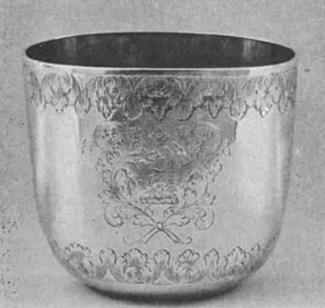 |
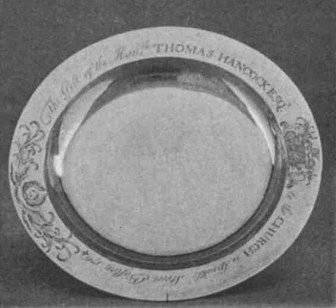 |
Cup by unknown maker
|
Plate by Samuel Minott
|
All the pieces are rare and many are unique; while in
general lines they follow the fashion and forms of old England,
certain of them show charming individuality of shape and
decorative motive not found in the plate made in Europe.
The collection contains over one hundred and forty beautiful
pieces of hollow ware. Its completeness enables an exhaustive
study of the chronological development of the various forms of
beakers, tankards, porringers, mugs, and teapots, and various
other articles used upon the table. Spoons, sugar tongs, etc.,
are to be found in great abundance. In fact, an exhaustive
catalogue of the collection would form a textbook of American
silver and its makers.
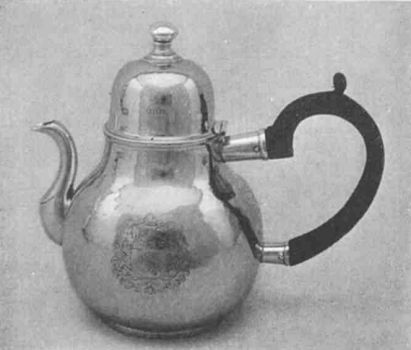 |
The collection is especially rich in the work of the
silversmiths who lived in Boston during the later part
of the seventeenth and the early years of the eighteenth
century. These have a greatly added interest in that
they are the work of men, all of whom took a prominent
part in the development of New England -its resources
and democracy.
The wondrous life stories of many of the makers of these
pieces of American silver have already been told in the
lengthy historical introductions of the catalogues of
loan exhibitions held in the Boston (1906) and
Metropolitan Museums (1911). Enough has already been
written to give us an insight into the histories,
personalities, and environment of these early colonial
craftsmen and to make these examples of their handiwork
very personal and almost human. It is not the purpose of
this article of appreciation of the results of Judge
Clearwater's collecting to retell these tales.
Probably to many the most fascinating piece in the
collection is a teapot of wonderful texture and color
made by John Coney (1655-1722) of Boston, who it will be
remembered engraved the plates for the first paper money
used in America. The coat of arms it bears testifies to
this early American engraver's skill with his engraving
tools. It is the earliest American teapot of which we
know. A tankard and a porringer by the same maker are
noteworthy pieces.
|
Teapot by John Coney (1655-1722)
|
|
Judge Clearwater has been extraordinarily fortunate
in securing four remarkable pieces bearing the mark of
Edward Winslow (1669-1753), also of Boston, whose work
entitles him to be recorded as the greatest of our
colonial silversmiths. He was an American, the grandson
of the John Winslow who came over in the Fortune in
1623, and on his mother's side was a direct descendant
of Anne Hutchinson -that goodly dame whose life figured
so largely in early New England and New York history.
Winslow, in common with almost all of our
early silversmiths, was very prominent in the civic life
of the community. He served successively as constable,
tithing-man, surveyor, overseer of the poor, selectman,
and sheriff of Suffolk County (1728-43); from this
office he was appointed Judge of the Inferior Court of
Common Pleas.
Defense in those days was not the neglected problem
it is today. In 1702 he was second lieutenant in the
artillery company and in 1714 its captain; he was major
of the Boston regiment in 1729 and its colonel in 1733.
The elaborately wrought chocolate pot and beautifully
fashioned plate illustrated herewith, and two tankards
demonstrate the very high order of his craftsmanship.
|
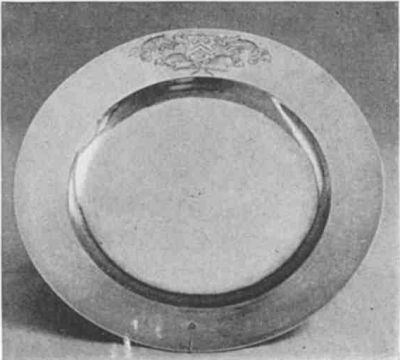 |
| |
Plate by Edward Winslow (1669-1753)
|
William Cowell (1682-1736) is represented by a porringer. It
is the same Cowell thus referred to by Samuel Sewall under date
of June 21,1707: "Billy Cowell’s shop is entered by the chimney
and a considerable quantity of plate was stolen. "
John Dixwell (1680-1725), the son of the "regicide, " Col.
John Dixwell, who found an asylum in America and lived in
retirement in New Haven, is another of these early
eighteenth-century silversmiths whose work may be viewed in the
collection.
John Burt (1691-1745) was the maker of the splendid brazier
illustrated below. Of equal interest is the work of his son
Benjamin Burt (1729-1804).
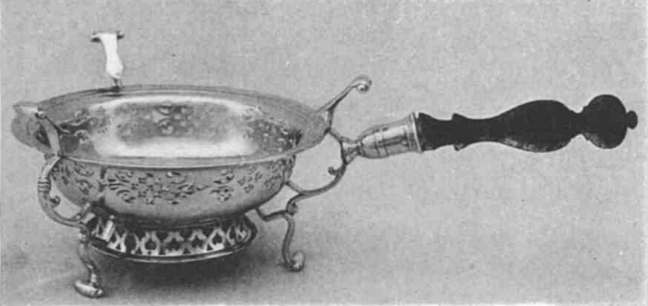 |
Brazier by John Burt (1691-1745)
|
The work of the Reveres, father and son, is also
well represented. The father, a Huguenot boy, served his
apprenticeship under Coney; the son, the patriot and
messenger of prerevolutionary days, was only nineteen
years old when his father died and left him to carry on
the trade which he had so successfully developed.
The exquisite teapot of the period of 1790, illustrated
on the right, has aesthetic qualities which demonstrate
Revere's artistic excellence.
|
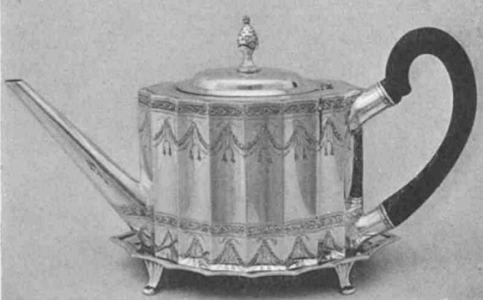 |
| |
Teapot by Paul Revere (1735-1818)
|
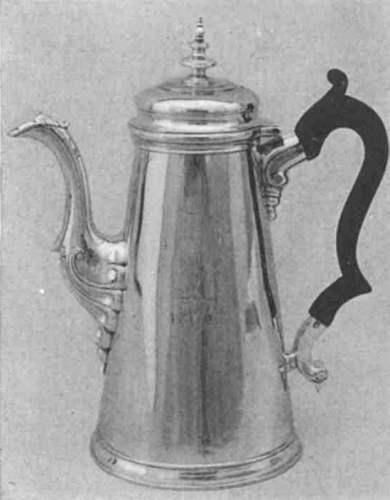 |
Salem, Providence, Newport, and Philadelphia have
contributed to this splendid collection.
New York is adequately represented.
A splendid coffee pot of the middle of the eighteenth
century, fashioned by Pygan Adams of New London,
indicates that superb craftsmanship flourished outside
of the confines of our largest cities.
|
Coffee pot by Pygan Adams (1712-1776)
|
|
Undoubtedly, the most beautiful piece of New York silver in
the collection is a beaker made by some late seventeenth-century
Knickerbocker silversmith. Its makership cannot be identified,
however, owing to the partial obliteration of the maker’s mark.
It is a form greatly in vogue among our early New York
silversmiths, whose work as a rule followed closely the
conventional forms and decorations of the Dutch silversmiths.
This same Dutch influence is found in many examples of English
plate of the sixteenth century; in form and ornament, the beaker
closely resembles a London beaker bearing the date-letter of the
year 1599.
To all Americans who rejoice in the stories of our country’s
past -its ideals and its struggles to maintain them- and to all
jealously apprehensive of our country’s future -endangered by
isms and political nostrums- this ancient silver of Judge
Clearwater must have an added charm which no foreign plate can
possibly possess; for it represents the work and personalities
of men who gave to the country the best they possessed in the
form of service to church and state and thereby assisted in the
gradual moulding and welding together of the various integral
units of colonial life into the great republic of which we are
so proud and whose traditions we hold so dear.
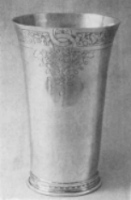 |
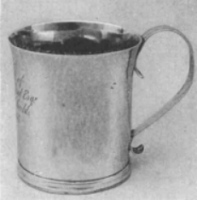 |
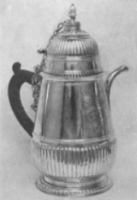 |
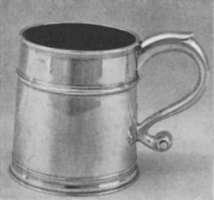 |
Beaker, New York
17th century
|
Mug by John Dixwell
(1680-1725)
|
Chocolate pot
by Edward Winslow (1669-1753)
|
Mug by Kaiser Griselm
(late 17th century)
|
R. T. H. HALSEY
This article was firstly published in Metropolitan
Museum of Art Bulletin 1 (January 1916)
|
|
|
 ASSOCIATION OF SMALL COLLECTORS OF ANTIQUE SILVER
ASSOCIATION OF SMALL COLLECTORS OF ANTIQUE SILVER ASSOCIATION OF SMALL COLLECTORS OF ANTIQUE SILVER
ASSOCIATION OF SMALL COLLECTORS OF ANTIQUE SILVER